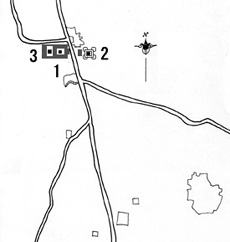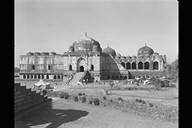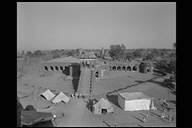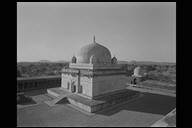 |
1.JAMA
MASJIDü@(1454) 2.TOMB OF MAHMUD KHAJI (c.1475) ü@ü@ü@& ASHRAFI MAHALü@(The first half of 15th C.) 3.HOSHANG SHAH'S TOMB ü@ü@(c.1432) |
MANDUü@III.The
Neighbourhood of the JAMA MASJID
 |
1.JAMA
MASJIDü@(1454) 2.TOMB OF MAHMUD KHAJI (c.1475) ü@ü@ü@& ASHRAFI MAHALü@(The first half of 15th C.) 3.HOSHANG SHAH'S TOMB ü@ü@(c.1432) |
ü@
 |
ü@Viewing from its
scale, the structural method of stone materials, and the
fact that there are not many complicated patterns
sculpted except for a small part of this building such as
mihrab in the west side of the prayer room, this remain
gives the impression of a simple yet majestic monument.
The left half of an inscription hung above the east gate
has been damaged but from the Persian inscription on the
right half, we can discover that this mosque was built by
"will of Hoshang" to be explained later and was
completed by "Sultan Ala ad-Din", also known as
Muhmud Khalji in 858 AH (1454). (Matsuo Ara) ü@ü©Detailed Explanation ü@ü©The list of photos |
ü@
2.TOMB OF MAHMUD KHAJI
& ASHRAFI MAHALü@
 |
ü@This building, of
which we can only observe remnants, has a name meaning
"noble palace" and it was built originally as
madrasa under Hoshang Shah's reign. It is assumed that
this used to be the most magnificent building of all in
Mandu. The entire building is constructed on a majestic
basement, on which arch-shaped rooms stretch in a row and
four towers built at the four corners. It has a gate at
the top of an existing staircase in the south side.
Fortunately this gate still remains. (Matsuo Ara) ü@ü©Detailed Explanation ü@ ü@ü©The list of photos |
ü@
 |
ü@Alp Khan, also
known as Hoshang Shah, who succeeded his father and
ascended the throne of sultan, left grand buildings in
the 27 years of his control of the Malwa region, due to
his love of architecture. Along with Jama Masjid, Delhi
Darwaza and the above madrasa (Ashrafi Mahal), his own
tomb is included in these buildings. Hoshang Shah died in
1435 but a tomb, which he compelled his people to build
for him was completed by his son Muhmud Shah, who
succeeded him. (Matsuo Ara) ü@ü©Detailed Explanation ü@ü©The list of photos |
ü@